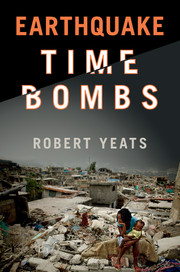Book contents
- Frontmatter
- Contents
- Acknowledgments
- Why this book?
- PART I EARTHQUAKES, DEEP TIME, AND THE POPULATION EXPLOSION
- PART II EARTHQUAKE TIME BOMBS
- TIME BOMBS WHERE THE PROBLEM IS UNDERSTOOD, BUT THE RESPONSE IS STILL INADEQUATE
- 6 San Francisco Bay Area
- 7 Los Angeles
- 8 Seattle, Portland, and Vancouver: Cascadia subduction zone
- 9 Japan: Tokyo and the Kansai
- 10 Wellington, New Zealand
- 11 Santiago, Chile
- 12 Prologue in central China
- OTHER TIME BOMBS, INCLUDING CITIES THAT ARE NOT WELL PREPARED
- PART III SUMMARY AND RECOMMENDATIONS
- References
- Index
7 - Los Angeles
from TIME BOMBS WHERE THE PROBLEM IS UNDERSTOOD, BUT THE RESPONSE IS STILL INADEQUATE
Published online by Cambridge University Press: 05 November 2015
- Frontmatter
- Contents
- Acknowledgments
- Why this book?
- PART I EARTHQUAKES, DEEP TIME, AND THE POPULATION EXPLOSION
- PART II EARTHQUAKE TIME BOMBS
- TIME BOMBS WHERE THE PROBLEM IS UNDERSTOOD, BUT THE RESPONSE IS STILL INADEQUATE
- 6 San Francisco Bay Area
- 7 Los Angeles
- 8 Seattle, Portland, and Vancouver: Cascadia subduction zone
- 9 Japan: Tokyo and the Kansai
- 10 Wellington, New Zealand
- 11 Santiago, Chile
- 12 Prologue in central China
- OTHER TIME BOMBS, INCLUDING CITIES THAT ARE NOT WELL PREPARED
- PART III SUMMARY AND RECOMMENDATIONS
- References
- Index
Summary
After the 1906 earthquake, the scene shifted to the Los Angeles metropolitan area. Unlike San Francisco, Los Angeles was considered by the general public as relatively free from earthquakes, although earthquakes were felt in the desert east of Los Angeles. Earthquakes had taken place in Los Angeles as early as 1769 during the Portolá exploratory expedition and again in 1800 and 1812, when earthquakes severely damaged the San Juan Capistrano mission south of Los Angeles. However, these earthquakes took place when California was still Alta California, a territory ruled by Spain. These events took place too long ago to be part of any conversation about earthquake hazards, although an earthquake in 1920 damaged the Inglewood district near the soon-to-be-discovered Newport–Inglewood fault. After that earthquake, despite the efforts of John C. Branner of Stanford, the propaganda machine of Los Angeles developers swung into action to reassure investors that Los Angeles had nothing to fear from San Francisco-type earthquakes! But then, an earthquake of magnitude 6.4 hammered the small resort city of Santa Barbara in 1925, taking 12 lives, but again the business interests minimized awareness of the damage and danger. People living in Santa Barbara did not appreciate their losses being downplayed in this way, even by their own Congressional representative.
However, there was now a research institution in southern California interested in earthquakes: the California Institute of Technology (Caltech), including engineers, seismologists, and geologists. Its president, Robert Millikan, a future Nobel Prize-winning physicist, was a major influence on a recently graduated physicist-turned-seismologist named Charles Richter.
On March 10, 1933, the Long Beach earthquake of magnitude 6.4 struck the Newport–Inglewood fault, taking 120 lives and inflicting damage of more than $400 million in today's dollars. The propaganda machine, led by the Los Angeles Chamber of Commerce, dutifully rolled out its usual soothing remarks, but it was now the middle of the Great Depression, and resistance was weak because of the collapse of the real-estate market. In addition, the earthquake severely damaged schools in the region, and outraged parents went directly to Sacramento, the state capital, to demand action. The result was the Field Act and Riley Act, with the Field Act the more important since it was enforced at the state level.
- Type
- Chapter
- Information
- Earthquake Time Bombs , pp. 85 - 100Publisher: Cambridge University PressPrint publication year: 2015



